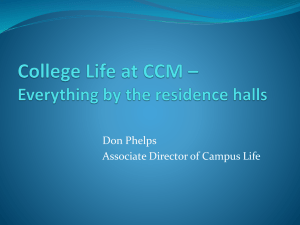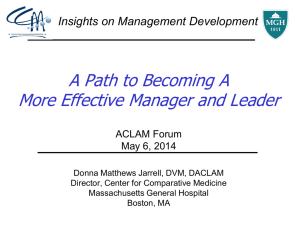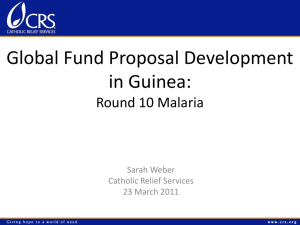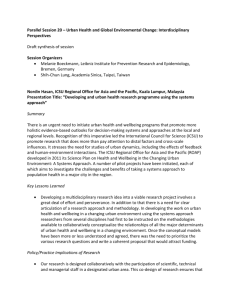(Ed.), Handbook of research for educational
advertisement
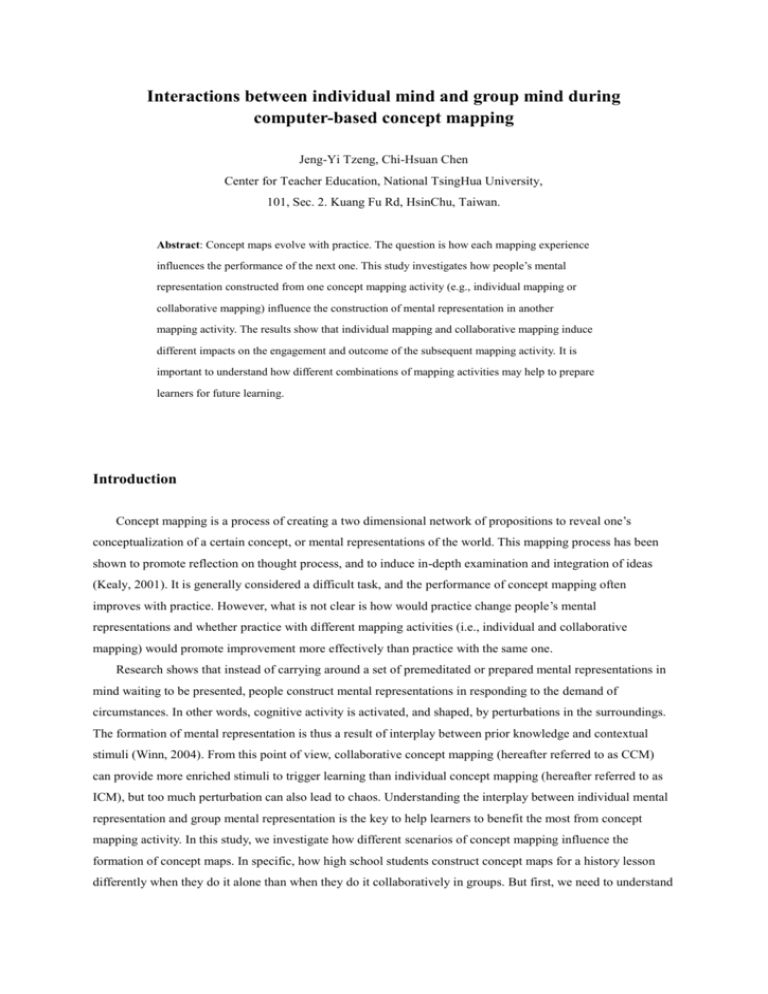
Interactions between individual mind and group mind during computer-based concept mapping Jeng-Yi Tzeng, Chi-Hsuan Chen Center for Teacher Education, National TsingHua University, 101, Sec. 2. Kuang Fu Rd, HsinChu, Taiwan. Abstract: Concept maps evolve with practice. The question is how each mapping experience influences the performance of the next one. This study investigates how people’s mental representation constructed from one concept mapping activity (e.g., individual mapping or collaborative mapping) influence the construction of mental representation in another mapping activity. The results show that individual mapping and collaborative mapping induce different impacts on the engagement and outcome of the subsequent mapping activity. It is important to understand how different combinations of mapping activities may help to prepare learners for future learning. Introduction Concept mapping is a process of creating a two dimensional network of propositions to reveal one’s conceptualization of a certain concept, or mental representations of the world. This mapping process has been shown to promote reflection on thought process, and to induce in-depth examination and integration of ideas (Kealy, 2001). It is generally considered a difficult task, and the performance of concept mapping often improves with practice. However, what is not clear is how would practice change people’s mental representations and whether practice with different mapping activities (i.e., individual and collaborative mapping) would promote improvement more effectively than practice with the same one. Research shows that instead of carrying around a set of premeditated or prepared mental representations in mind waiting to be presented, people construct mental representations in responding to the demand of circumstances. In other words, cognitive activity is activated, and shaped, by perturbations in the surroundings. The formation of mental representation is thus a result of interplay between prior knowledge and contextual stimuli (Winn, 2004). From this point of view, collaborative concept mapping (hereafter referred to as CCM) can provide more enriched stimuli to trigger learning than individual concept mapping (hereafter referred to as ICM), but too much perturbation can also lead to chaos. Understanding the interplay between individual mental representation and group mental representation is the key to help learners to benefit the most from concept mapping activity. In this study, we investigate how different scenarios of concept mapping influence the formation of concept maps. In specific, how high school students construct concept maps for a history lesson differently when they do it alone than when they do it collaboratively in groups. But first, we need to understand how the literature defines “difference” in concept maps. Formations of concept maps According to Lambiotte, Dansereau, Cross, & Reynolds, (1989), a concept map is essentially composed of three types of knowledge prototype: descriptive hierarchies, logic and action chains, and concept clusters. In addition, Hay and Kinchin’s (2006) also proposed three conceptual typologies; i.e., spoke, chain, and net. While knowledge prototypes constitute the schematic building blocks for the formation of typologies, typologies of concept maps reveal varieties in the cognitive operations underlying the process of concept mapping. First, although descriptive hierarchies and concept clusters present different formations (i.e., the former features a top-down tree-like structure, whereas the latter features a center-to-periphery structure), they both address categorization and both branch out from the most general to the most specific—a structure manifests the spoke typology. According to Hay and Kinchin, when people create concept maps featuring the spoke typology, they often have concept-related knowledge but probably cannot fully explain the why and the how questions associated with it. Second, a logic and action chain presents a causal relation between nodes. A collection of logic and action chains can build up to a concept map featuring either the chain or the net typology. The chain typology has all the nodes lined up in one chain-like sequence. People who create chain-type concept maps have either problematic comprehension of the content, inadequate ability to restructuring the concepts, or inclination to rush through the mapping process. Without a firm grip on the logic and the organization of the content, chain-type thinking is prone to conceptual collapse. In contrast, the net typology, driven by logic and causal relations, requires mapmakers to reflect on and analyze the construct of the concept. It seeks diversified but inter-connected routes of thought to create multifaceted, yet integrated, characterization of the concept. People who create net-typed concept maps show that they can think flexibly, innovatively, and systematically. Collaborative concept mapping As the socioconstructivist paradigm becomes one of the major thrusts in education today, whether, and if so how, collaborative learning can enhance knowledge construction and learning performance is a major concern to both educational researchers and practitioners. In this regard, CCM shows great potential, albeit still being considerably understudied (Gao, et al., 2007). When a group of people collaboratively create a concept map, they do not simply retrieve whatever is on their mind about the concept and then put it together. What they put forth on the map is actually contingent upon what others do to the map. The constant changing of the map presents continual perturbation to individual group member’s otherwise blinkered cognitive operation. This process of collaboration not only promotes the activation of individuals’ prior knowledge, but arranging nodes and links to other members’ acceptance also requires group members to communicate their tacit understandings of what is being displayed on the map with each other (Gao, et al.). In addition to the finding that CCM can lead to significant improvement in knowledge gain, and more effective knowledge construction, many studies also found that CCM can create stronger positive impact on learning than ICM. First of all, research shows that collaborative maps can represent the target concept with better quality than individual maps. Moreover, CCM activities are associated with stronger improvement in learning (measured by post-mapping achievement test, problem solving test, or comprehension test) than ICM activities, especially when the collaboration involves students creating, rather than completing, a concept map together in groups. Regarding the differential effect of varied contexts on performance of concept mapping, most of the studies comparing face-to-face collaboration with computer-mediated collaboration found no significant differences in post-mapping tests on learning outcome or mode of communication (Basque, 2004) However, several negative effects of CCM are also reported in the literature. For example, research shows that CCM did not improve students’ self-efficacy or attitude toward the learning task. In some cases, once incorrect notions were introduced, they were often unchallenged during the map creating process and eventually stayed in students’ mind. Moreover, interactions among group members rarely focus on the most essential part of knowledge construction; that is, the creation and the arrangement of nodes and links, possibly because students normally pay little attention to each other’s comments. Solutions to mitigate the negative effects and thus to generate better knowledge construction from CCM include providing scaffolding and support, combining concept mapping activities with other instructional strategies, and engaging map makers in pre-mapping preparation, for example, constructing propositions individually before collaboration begins (Cartre, 1998). Method This is a quasi experimental study conducted in a high school located in the central area of Taiwan with participation of one hundred and twenty five 7th grade students. These students were streamed into four classes of equal learning capacity on the basis of the result of an academic competency test taken in advance of the semester; therefore, no pre-study disparity between these four classes was expected. Participants spent an hour per week for five weeks on this experiment to learn how to use computer software (Cmap Tool) to create concept maps for history content individually and collaboratively in groups. In the first week, the teacher (who taught all of the four classes) explained the idea of concept mapping and the use of Cmap Tool. In the following three weeks, the teacher explained and demonstrated the strategies of creating concept maps out of paragraphs from a history textbook. The lessons included how to identify key concepts and relations, how to arrange them into knowledge prototypes, and how to present the structure of the content in different typologies with branches and cross-links. The participants also practiced concept mapping with various history concepts. In the fifth week, the participants constructed two concept maps consecutively, and both times for the same history concept (i.e., the 228 incident). The four classes were randomly assigned to one of the following four mapping conditions: (A) ICM first, then CCM; (B) CCM first, then ICM; (C) ICM first, then ICM again; and (D) CCM first, then CCM again. Each ICM or CCM session lasted 30 minutes. The participants were instructed to discuss with their group members in the Cmap Tool’s online chat room during CCM. All the actions in CCM along with the content of online chatting were screen recorded and then content analyzed. After the completion of the second concept mapping activity, the participants filled out a questionnaire which was translated and adapted from the Motivated Strategies for Learning Questionnaire (i.e., MSLQ) by Pintrich, Smith, Garcia, and McKeachie (1991). In order to delve into participants’ thinking process, we also conducted interviews with participants by groups after they finished the questionnaire. Tentative Findings Consistent with Cartre’s (1998) findings, the collaborative maps in group A demonstrated better quality, which is represented by more net and less chain typology, than those in group B. During collaborative mapping, the participants in group A tested out their methods of representing the concept, which they developed during ICM, and pressed for inclusion of their ideas in the final outcome. As a result, CCM often involves breaking the boundaries of ICM and accommodating divergent presentations of the concept. In a few cases, even when all of the individual maps featured nothing but chain typology, the ensuing collaborative maps somehow showed a great deal of spoke or net typology. On the other hand, during CCM in group B, the process of individuals’ constructing personal presentation for the concept was intertwined with the process of others’. The participants needed to figure out how to present their ideas, how others presented their ideas, and how to integrate different ideas at the same time. The chat room communication primarily focused on mapping-irrelevant matters, so it provided little help. As a result, it was difficult for both the individuals and the group to form a coherent conceptualization of the concept. Most collaborative maps in group B showed greater problems of incompleteness than its counterpart in group A and individual maps in group B. On the other hand, comparing individual maps in group A with group B showed that having a chance to collaborate on concept mapping in advance did not improve the quality of subsequent individual maps. In fact, there is a clear consistency of typological presentation between the collaborative maps and the individual maps that followed in group B. This consistency indicates that, from the process of collaboration, there emerged a collective supposition regarding how to represent the concept, which in turn served as a schema, or a structural reference, that shaped the way individuals created their own concept maps later on. Unfortunately, as mentioned earlier, unpredisposed collaboration tended to be poorly constructed. Therefore, collaborative mapping provided little, if not misguided, impact on individual mapping. No significant difference in the quality of individual maps between group A and B was found. The factor analyses followed by the cluster analyses on the data collected from the MSLQ show that different mapping sequences were associated with different learning behaviors. For example, the participants in group A considered themselves having significantly greater contribution to the group outcomes than those in group B. This result suggests that preparation before CCM help to promote mapmakers’ self-efficacy during CCM. The differences found between group A and B, and between the first and the second mapping activities within group A and group B, reveal the change of mental representation caused by different mapping scenarios. Investigation on the change of mental representation resulted from repeating the same mapping activity would provide further insights into the effect of practice on the quality of concept maps. We have collected the data from group C and group D, and we are currently working on coding the data for further analyses. The findings of this study not only can contribute to the discussion of the effect of practice and collaborative learning, but also can provide helpful insight into the discussion of “preparation for future learning” and “learning to learn.” References Basque, J. (2006). Collaborative concept mapping in education: Major research trends. In A. J. Cañas, J. D. Novak (Eds.) Proc. of the Second Int. Conference on Concept Mapping, San José, Costa Rica. Carter, C. W. (1998). A case study of meaningful learning in a collaborative concept mapping strategy as a preparation for a college biology laboratory. Unpublished doctoral dissertation. Georgia State University, Atlanta. Gao, H., Shen, E., Losh, S., & Turner, J. (2007). A review of studies on collaborative concept mapping: What have we learned about the technique and what is next? Journal of Interactive Learning Research, 18(4), 479-492. Hay, D. B., & Kinchin, I. M. (2006). Using concept maps to reveal conceptual typologies. Education & Training, 48, 127-142. Kealy, W. A. (2001). Knowledge maps and their use in computer-based collaborative learning environments. Journal of Educational Computing Research, 25, 325-349. Lambiotte, J. G., Dansereau, D. F., Cross, D. R., & Reynolds, S. B. (1989). Multirelational semantic maps. Educational Psychology Review, 1, 331-367. Pintrich, P. R., Smith, D. A. F., Garcia, T., & McKeachie, W. J. (1991). A manual for the use of the Motivated Strategies for Learning Questionnaire (MSLQ). Ann Arbor: University of Michigan. Winn, W. (2004). Cognitive perspectives in psychology. In D. Jonassen (Ed.), Handbook of research for educational communications and technology (2nd ed., pp. 79-112). New York, NY: Simon & Schuster.
